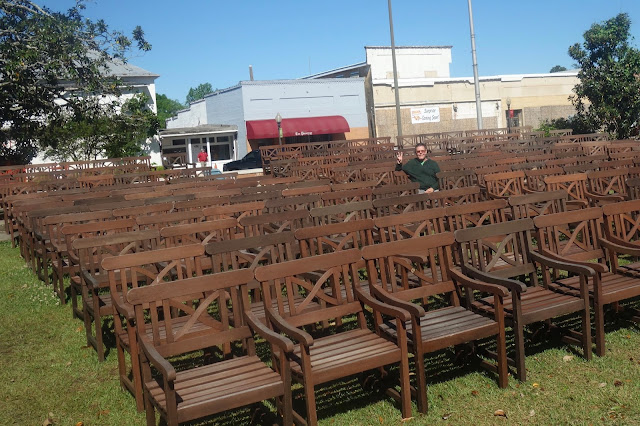The next morning we killed time at a colorful eyesore before town's primary attraction opened.
Gaudily painted lawn ornaments capture the area's conflicted history.
To be fair, they're greatly outnumbered by elephants that signal support for the Crimson Tide, the University of Alabama's football team.
You won't find a prettier town square on a perfect spring morning.
Images of mockingbirds appear more commonly than the birds themselves. Here's one on the facade of Lee Motors, whose website nevertheless studiously avoids any mention of the town's favorite daughter. Call it literary prestige by association.
The Monroe County Museum occupies the former courthouse, immortalized by Lee. The clocks actually work.
On weekends, visitors can watch outdoor performances of "To Kill A Mockingbird."
In Hollywood's adaptation of Lee's beloved novel, set designers re-created the court room almost exactly. Stepping into it is the only reason to visit the terrible museum. Too bad the photo of me pledging to "tell the whole truth and nothing but the truth didn't come out." I'll tell it here instead.
Here sat the not-so-imaginary jurors who wrongly convicted Tom Robinson of rape. I took this photo from the "colored section" in the balcony where Scout, Jem and Dill watched the trial.
A quilt hanging near the entrance depicts Capote with cousin Sook on an incongruous panel.
The museum counts a local teenager's scrapbook among its few archival items. There's also no mention of Lee's death more than three years ago, nor any reference to one of the biggest hits on Broadway this season, a new adaptation of her 59-year-old novel. Not even a playbill!
But don't miss this pathetic re-creation in a room of its own.
If I sound like a snob it's because of the way I was treated when I dared to draw a significant error to the attention of the administrative staff. A wall panel in the room dedicated to Capote claims that he published his last novel, Music for Chameleons, in 1958 even though a prior paragraph on the SAME panel notes that Breakfast at Tiffany's appeared in 1960. Chameleons wasn't published until 1980 and it isn't even a novel!
"Yes, we're aware," sniffed the same guy above his half glasses before dismissing me. Earlier, he gave us attitude when we asked where to find the rock commemorating Atticus Finch. I signed the visitor's register with a pissy vengeance.
We left the museum with the distinct feeling that it existed only as tourist draw for an otherwise empty town. The size of the gift shop and variety of tchtokes it stocked reinforced this impression. And if you're looking for the Atticus Finch rock, you'll find it behind the museum, not in front as indicated in the walking tour map.

















No comments:
Post a Comment